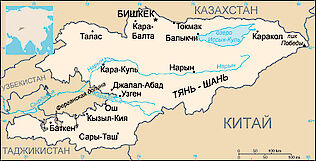Kyrgyzstan

Kyrgyzstan is a mountainous and not big country situated among mountains and valleys of the North Tien Shan. Reliable sources have permitted local and foreign historians to establish the fact that the state organization of Kyrgyz people counts twenty two centuries. The documents of Sym Tsjan, the well-known Chinese historian and chronicler, are the most ancient historical documents about Kyrgyz state organization. In 2003 Kyrgyzstan marked the 2200 anniversary of its state system and the long history of country is evident to visitors of Kyrgyzstan on the rock paintings near the Issyk-kul Lake and Burana tower.
Contemporary Kyrgyzstan is a tolerant country. More than 80 ethnic groups live in it, creating the variety of cultures and traditions. Russian and European impact can be seen at large streets and the impressive architecture of the capital, developing significantly during last years and capturing progressive tendencies of contemporary architecture and design.
The most illustrative examples of the Great Silk Way’s heritage can be found at the south of Fergana valley where the ancient Osh city used to be a fortress of Alexander Macedonian. Kyrgyzstan is a trade crossroad and a trans-shipment point between the Europe and Asia as before when it used to be a connecting-link between north and south directions of Silk Way.
Kyrgyzstan maintains friendly relations with many countries. These relations, based on durable cultural interaction, will develop and strengthen in future. Many welfare states are ready to share with Kyrgyzstan their experiences in developing the democracy and realizing reforms needful for the creation of prosperous market state.
Economic reforms, carried out in Republic, form the concrete directions of actions in order to remove barriers which are prohibitive for investment activity and the realization of the program by investment advance. Kyrgyzstan, trusting in the principles of freedom and democracy, is becoming a country able to the efficient social dialogue and dynamic development.
The Kyrgyz Republic - the state in the northeast of Central Asia. It is located within Pamiro-Alayi in the southwest and Tian-Shan - in the northeast. Borders - on Kazakhstan, Tajikistan, Uzbekistan and China.
State Symbols
Aspect: 1:2. It is a red cloth. The center posted a picture of sun-yellow. At Sun posted a symbolic image of Kyrgyz yurta.
Adopted in 1992, the red flag symbolizes the valor and courage. The sun symbolizes peace and wealth, and the image yurta - a symbol of the country and the world.
Arms of Kyrgyzstan – official state symbol of Kyrgyz Republic; designed by authors A. Abdraev and S. Dubanaev and accepted on 14 January 1994 by Decree of Parliament.
In the centre of arms against a background of Issyk Kul Lake and ridges of Ala Too, where the sun rises, situated image of white falcon with sprawled wings symbolizing freedom and independence of Kyrgyzstan. Silhouette of sun is a symbol of life, wealth and abundance. This element takes a main place in the state symbols. Top of mountains alighted by the sun looks like Kyrgyz national headwear- “kalpak”.
According to the ideology of nomads a special place belongs to steppe eagle or golden eagle. In the symbolic language silhouette of golden eagle means state power, wideness and far-sightedness. For steppe nomads it is symbol of freedom, independence, urge towards an aim, to highness, fly into future. On the Kyrgyzstan arms it is gyrfalcon “Ak - Shumkar” of Manas.
General Information
- Independence date - on August 31, 1991 (from the USSR)
- Languages - Kyrgyz - state, Russian - official.
- The form of government - the Parliamentary republic
- The president - Atambayev Almazbek Sharshenovich
- The speaker of Parliament - Zheenbekov Asylbek Sharipovich
- The prime minister - Otorbaev Djoomart Kaipovich
- Currency - Kyrgyz som (KGS, a code 417)
- The Internet domain-.kg
- Telephone code - +996
- Time zones - UTC +6
- Territory: 199,9 thousand sq.km (5,8 % - the woods, 4,4 % - waters, 53,3 % - agricultural grounds, 36,5 % - other lands). Nearly 90 % are located above 1500 m above sea level.
- Number of resident population for January 1, 2018 - 6,2 million people.
- The capital - Bishkek (1 million people).
- Big cities: Osh (288 thousand), Dzhalal Abad (117.2 thousand), Karakol (77.7 thousand).
- Shares on 7 administrative areas — Chuy, Talas, Issyk-Kul, Naryn, Jalal-Abad, Osh and Batken. The regional centers - Talas, Karakol, Naryn, Dzhalal Abad, Osh, Batken.
- The highest point - Pobeda Peak - 7439 m
- The longest rivers, km
- Naryn - 535
- Chatkal - 205
- Choo - 221
- The largest lakes, sq.km
- Issyk Kul - 6236
- Son-Kul - 275
- Chatyr-Kul - 175
Climate - sharply continental with cold winter and in the hot summer, strictly depending on height above sea level. A precipitation, generally concentrates in the autumn, in the winter and in the spring while the summer usually happens dry.
Religions - the majority of believers – Muslims. There are Christians: orthodox, Catholics and Protestants (Lutherans, baptists, Adventists).
The Republic parliament — to Zhogorku Kenesh has a priority of the decision and definition of the most important decisions and policy of the state, is unicameral, and consists of 120 deputies elected for a period of five years on party lists.
The President is elected by national vote for a period of 6 years, without the right of re-election to the second term. The same person can't be elected the President twice.
The Head of the government — the prime minister, is appointed by parliament on representation of parliamentary fraction of the majority (deputies from the political party which has received more than 50 percent of mandates).





